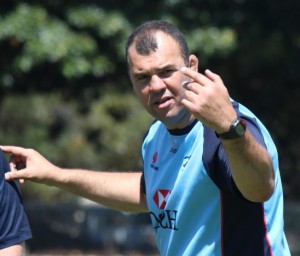I’m a great fan of attacking rugby but attacking rugby is about more than playing running rugby and scoring tries. I have been enthralled by plenty of matches where defences dominate and there are limited tries scored.
- Fewer numbers committed to breakdown
- Forward support runners maintain distance from ball carrier
- Run it out of their own 22
- Lack of 1st phase attack plays so far
You can attack through your set piece play as the Brumbies have done so effectively in the first two weeks of the Super Rugby competition, you can attack in defence as France did so well against the Wallabies last year and you can attack the breakdown to secure clean ball to attack with or to disrupt the opposition’s flow in attack. You can even attack through a kicking strategy as the Wallabies did against England last year with short kicks in behind the rushing defensive line.
If you play attacking rugby in all aspects of the game, you’ll win a fair share of possession and will be able to play running rugby, although you still may not score tries because the opposition’s defence is too good. The important thing for me is that a team shows the intent to attack in all areas of the game for the majority of the match. Of course when a team doesn’t have an attacking intent it makes it very hard to get in position to score tries as we saw with the Wallabies last year.
On Friday night we saw a magnificent game of attacking rugby between the Highlanders and Chiefs. The skills, the pace and the attacking intent from both teams were superb and were not matched by the Australian teams over the weekend – it provided something to aspire to.

When Michael Cheika was appointed as the Waratahs new coach he made it clear that he would insist on his team playing attacking rugby. There have been numerous reports from the Waratahs trial matches that suggested that the team has embraced the attacking philosophy of Cheika but against the Reds last Saturday we had the first opportunity to see this new style in a match where the points mattered.
I was of course interested to see whether Cheika’s attacking rugby just meant running rugby and keeping the ball in hand or something more. Watching the match live it was apparent that the Waratahs weren’t going to attack the breakdown – it was noticeable that the Waratahs wanted to commit limited numbers to rucks both in attack and defence presumably so that they had extra players available away from the ruck to help in defence or attack on the next phase.
In the opening round match of Super Rugby between the Brumbies and Reds the contest at the breakdown was a real feature with both teams committing large numbers in attacking rucks to aid in retaining their ball and to try and ensure it was available quickly. When we interviewed Laurie Fisher on the Podslam after that match he made no secret of the fact that the Brumbies view was to try and get three players into each ruck in addition to the ball carrier.
In that match against the Brumbies the Reds seemed to have a similar view and with the Waratahs committing less numbers in this match the Reds had a platform for their own attack and the opportunity to disrupt the flow of quick ball from the ruck that would allow the Waratahs to play running rugby. Too often the Waratahs had to commit numbers to the breakdown late to try and stop the Reds from stealing their ball.
Having now had the chance to look at the match in more detail the reason the Waratahs were not committing numbers to the breakdown in attack was largely a result of their forward attack structure. Clearly the Waratahs don’t want to get bogged down in trench warfare by keeping the ball close to the ruck and want their forwards carrying the ball much wider. The second element of this strategy appears to be having the support runners maintain some distance from the ball carrier, presumably so that they are available as a wider running option for the ball carrier to distribute to.
In this match this attack structure meant that if the ball carrier took the ball into contact they were isolated and the support runners had to come from a fair distance away to get into the ruck. Often there was only one support runner which made it very difficult to secure quick, clean ball.
By contrast the Reds and Brumbies attack pattern is to run their forwards much closer to the ruck and with plenty of close support. Both of those teams can change up their attack from time to time and attack through wider running forwards.
Of course the lack of close support runners for the Waratahs getting into the breakdown early may be a result of a lack of fitness early in the season but given that it was in use right from the start of the match and was used in the vast majority of phases where the Waratahs had the ball suggests it is a clear strategy.
Examples are included in part one of the video below.
[youtube id=”Ly10aPQW5Ds” width=”600″ height=”350″]
The other noticeable element of the Waratahs attack was that they were prepared to retain the ball and try and run it out of their own 22. Over the last few seasons the Waratahs have certainly alienated a lot of fans with their kick first strategies but there is a place for kicking, particularly when it is from deep within your own territory. There are not many teams in professional rugby that take the option of running from deep unless they are behind and chasing a result.
On four occasions in the match against the Reds the Waratahs tried to run the ball out of their own 22 and all failed. Two of those attempts failed due to the ball being dropped and both came at crucial times giving the Reds good field position to attack from. The first was from the kickoff after halftime when the ball was dropped on the second phase by Tom Carter. The second was from the kickoff after the Waratahs had levelled the scores when the ball was again dropped on the second phase by Wycliff Palu.
In his post game interview a clearly frustrated Cheika said “We showed that we’re prepared to play a new style of game even maybe sometimes to our own detriment but we’re committed to doing that because we believe it’s the way to teach ourselves to go forward and be successful.”
Whilst those two dropped balls within their own 22 were detrimental to the Waratahs even on the other two occasions when they were able to retain the ball the strategy failed. On the first occasion the Waratahs held the ball within their own 22 for seven phases, lost 10 metres and then ended up kicking the ball away to give the Reds a lineout 10 metres outside the 22. On the second occasion the Waratahs held the ball in their 22 for 3 phases, again lost 10 metres and again then kicked the ball away to give the Reds a lineout just outside the 22.
Obviously players are still getting used to the new style of game Cheika has introduced. On the four occasions I’ve just discussed, it would have been better to kick the ball to improve field position. However on a number of other occasions when there were genuine opportunities to run the ball rather than kick it, the Waratahs chose to kick the ball and ignore the opportunity to keep the ball in hand in scenes reminiscent of last season.
Examples are included in part two of the video below.
[youtube id=”X1yIjzm0HII” width=”600″ height=”350″]
One thing I didn’t see from the Waratahs, which disappointed me, was any first phase attack plays. Given that Alan Gaffney is now in charge of first phase attack I was looking for some of his signature plays. Hopefully that’s on the menu next week.
It will be interesting to see whether the wide ranging attack structure for the forwards and the run the ball from deep strategies can work at this level of the game or whether Cheika will need to tweak his plans as the season progresses.
If he does stay the course, as he’s suggested he will, I expect teams will be targeting the Waratahs breakdown and rushing up in defence whenever the Waratahs have the ball in their own 22. Playing two open side flankers may become a real option against the Waratahs so maybe we will see David Pocock and George Smith operating in tandem in round 4!

